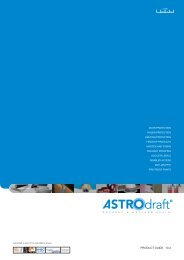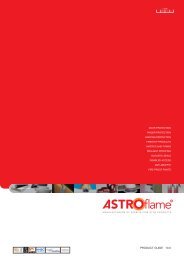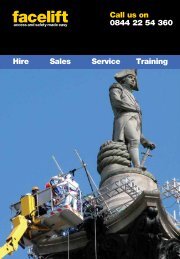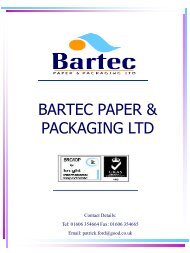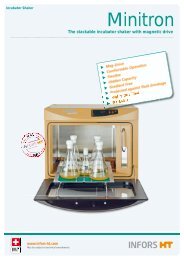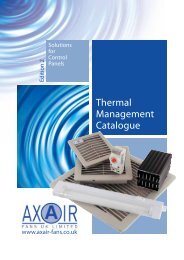fastening & assembly solutions and technology - Approved Business
fastening & assembly solutions and technology - Approved Business
fastening & assembly solutions and technology - Approved Business
You also want an ePaper? Increase the reach of your titles
YUMPU automatically turns print PDFs into web optimized ePapers that Google loves.
FAST OCTOBER 2011<br />
PRODUCT REVIEW: Quick release fasteners<br />
The quick acting fastener<br />
is making a comeback<br />
Market forces are causing OEMs to rethink <strong>fastening</strong> strategy by reviving a system that<br />
had for years been thought of as too expensive for general commercial use. Special correspondent<br />
Sam Kerr-Smiley reports<br />
In recent years, the quarter turn has<br />
been widely used to fasten automotive<br />
noise shields. These components have<br />
been specified for the removable panels<br />
that are fitted beneath vehicle engine<br />
bays to provide additional sound deadening.<br />
When the vehicles are serviced, these<br />
panels are removed to gain access to<br />
parts of the engine that require attention,<br />
especially with commercial vehicles with<br />
shorter service intervals.<br />
The quarter turn was originally developed<br />
in 1932 when William Dzus created<br />
his famous fastener for use in the<br />
fledgling US aviation industry; although,<br />
at that time, its use was primarily<br />
military.<br />
Designed for <strong>fastening</strong> panels over<br />
areas where regular servicing or frequent<br />
access was required the quarter-turn<br />
became a widely used st<strong>and</strong>ard with<br />
many applications; indeed it’s remained<br />
in production ever since – at the time of<br />
Dzus’ death in 1964 there were around<br />
20<br />
6000 variations – but although many<br />
tried to develop it to reduce overall inplace-cost,<br />
the quarter turn, with its<br />
expensively, separately milled external<br />
spiral cam has, until recently, been<br />
unable to bridge the cost gap caused by<br />
Far Eastern bulk production of nuts, bolts<br />
<strong>and</strong> screws, therefore remaining an<br />
expensive proposition for OEM’s.<br />
Which is really just what they want to<br />
avoid, particularly in these constrained<br />
times – but show an OEM a way they can<br />
demonstrably improve the benefits avail-<br />
Fast turn studs are unlocked in seconds<br />
able to their customers <strong>and</strong> they will pay<br />
attention. This is exactly what Unifast did<br />
when it was given the opportunity to<br />
design a <strong>fastening</strong> system to secure gearbox<br />
noise shields for commercial vehicle<br />
giant Iveco – taking the quarter turn principle,<br />
re-developing it for cost effective<br />
high volume production into the Fastturn<br />
quick acting system.<br />
Fast-turn, as the child of both dem<strong>and</strong><br />
<strong>and</strong> innovation, uses new production<br />
techniques, which combined with<br />
advances in materials <strong>and</strong> tooling, allows<br />
Unifast to manufacture the system on<br />
high speed, fully automated processes<br />
<strong>and</strong> deliver a product that is capable of<br />
beating the in-place-cost (IPC) of traditional<br />
systems by, in many cases, as much<br />
as 60 per cent.<br />
Design <strong>and</strong> production<br />
The traditional quarter turn fastener has<br />
been re-designed <strong>and</strong> re-engineered into<br />
a thoroughly modern joining system, <strong>and</strong><br />
while the research <strong>and</strong> development outlay<br />
was significant it has ultimately<br />
delivered an integrated <strong>fastening</strong> solution<br />
with benefits across production <strong>and</strong><br />
application.<br />
Luca Bergadano, Unifast’s spokesman<br />
explained: “Advanced manufacturers are<br />
now able to use a cold forming process to<br />
make the entire stud, significantly reducing<br />
waste <strong>and</strong> time, <strong>and</strong> most importantly,<br />
completing it without needing to mill<br />
on the external spiral cam.”<br />
Cold forming delivers near, or absolute,<br />
net shape, eliminating the need for<br />
secondary operations <strong>and</strong> as it uses 100<br />
per cent of the metal it leaves no scrap or<br />
swarf, generating significant savings in<br />
materials cost, as well as through the production<br />
process by reducing down time<br />
needed for cleaning <strong>and</strong> maintenance.<br />
Larger volumes, especially over longer<br />
production runs, will clearly demonstrate<br />
improved throughput <strong>and</strong> significant savings<br />
on materials usage.<br />
“We employ cold forming,”<br />
Bergadano continued, “not only because<br />
it delivers cost savings, but also because<br />
it adds to the quality of the manufactured<br />
component.<br />
“Machining a part from metal bar can<br />
disrupt <strong>and</strong> break its crystalline structure,<br />
which could introduce weakness into the



